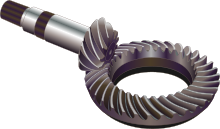Two important ideas in gearing are pitch surface and pitch angle. The  pitch surface area of a gear is the imaginary toothless surface area that you would possess by averaging out the peaks and valleys of the average person teeth. The pitch surface of a typical gear is the form of a cylinder. The pitch angle of a gear is the angle between your encounter of the pitch surface area and the axis.
pitch surface area of a gear is the imaginary toothless surface area that you would possess by averaging out the peaks and valleys of the average person teeth. The pitch surface of a typical gear is the form of a cylinder. The pitch angle of a gear is the angle between your encounter of the pitch surface area and the axis.
The most familiar types of bevel gears have pitch angles of less than 90 degrees and therefore are cone-shaped. This kind of bevel gear is named external because the gear teeth point outward. The pitch surfaces of meshed external bevel gears are coaxial with the gear shafts; the apexes of the two areas are at the idea of intersection of the shaft axes.
Bevel gears that have pitch angles of greater than ninety degrees possess teeth that time inward and are called internal bevel gears.
Bevel gears which have pitch angles of specifically 90 degrees have teeth that point beval gearbox outward parallel with the axis and resemble the points on a crown. That’s why this kind of bevel gear is called a crown gear.
Mitre gears are mating bevel gears with equal numbers of teeth and with axes at right angles.
Skew bevel gears are those for which the corresponding crown equipment has teeth that are directly and oblique.
